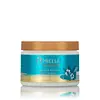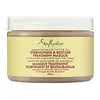What's inside
What's inside
 Key Ingredients
Key Ingredients

 Benefits
Benefits

 Concerns
Concerns

 Ingredients Side-by-side
Ingredients Side-by-side

Water
Skin ConditioningCocos Nucifera Oil
MaskingGlycerin
HumectantIsopropyl Palmitate
EmollientCaprylic/Capric Triglyceride
MaskingStearyl Alcohol
EmollientVp/Va Copolymer
Ceteareth-20
CleansingDiheptyl Succinate
EmollientCapryloyl Glycerin
Glycol/Sebacic Acid Copolymer
AbrasivePropanediol
SolventPanthenol
Skin ConditioningSteareth-2
EmulsifyingCaprylyl Glycol
EmollientAminomethyl Propanol
BufferingPersea Gratissima Oil
Skin ConditioningZingiber Officinale Root Oil
MaskingChamomilla Recutita Flower Extract
MaskingDisodium EDTA
Vaccinium Myrtillus Fruit Extract
Skin ConditioningSaccharum Officinarum Extract
MoisturisingAcer Saccharum Extract
Skin ConditioningCitrus Aurantium Dulcis Fruit Extract
MaskingCitrus Limon Fruit Extract
MaskingParfum
MaskingPhenoxyethanol
PreservativeWater, Cocos Nucifera Oil, Glycerin, Isopropyl Palmitate, Caprylic/Capric Triglyceride, Stearyl Alcohol, Vp/Va Copolymer, Ceteareth-20, Diheptyl Succinate, Capryloyl Glycerin, Glycol/Sebacic Acid Copolymer, Propanediol, Panthenol, Steareth-2, Caprylyl Glycol, Aminomethyl Propanol, Persea Gratissima Oil, Zingiber Officinale Root Oil, Chamomilla Recutita Flower Extract, Disodium EDTA, Vaccinium Myrtillus Fruit Extract, Saccharum Officinarum Extract, Acer Saccharum Extract, Citrus Aurantium Dulcis Fruit Extract, Citrus Limon Fruit Extract, Parfum, Phenoxyethanol
Water
Skin ConditioningCetearyl Alcohol
EmollientCocos Nucifera Oil
MaskingGlycerin
HumectantButyrospermum Parkii Butter
Skin ConditioningStearyl Alcohol
EmollientCetyl Alcohol
EmollientBehentrimonium Methosulfate
Parfum
MaskingBehentrimonium Chloride
PreservativePanthenol
Skin ConditioningHydrolyzed Wheat Protein
Skin ConditioningHydrolyzed Wheat Starch
Skin ConditioningCetrimonium Chloride
AntimicrobialPersea Gratissima Oil
Skin ConditioningMangifera Indica Seed Butter
Skin ConditioningOlea Europaea Fruit Oil
MaskingRicinus Communis Seed Oil
MaskingMentha Piperita Leaf Extract
Skin ConditioningMauritia Flexuosa Fruit Oil
Skin ConditioningYeast Extract
Skin ConditioningHydrolyzed Keratin
HumectantMacadamia Ternifolia Seed Oil
EmollientTocopherol
AntioxidantNiacin
SmoothingAloe Barbadensis Leaf Juice
Skin ConditioningAcetic Acid
BufferingHydrogenated Vegetable Oil
EmollientGlycine Soja Oil
EmollientTrifolium Pratense Flower Extract
AstringentCaramel
Cosmetic ColorantPropanediol
SolventCaprylhydroxamic Acid
Caprylyl Glycol
EmollientBenzoic Acid
MaskingWater, Cetearyl Alcohol, Cocos Nucifera Oil, Glycerin, Butyrospermum Parkii Butter, Stearyl Alcohol, Cetyl Alcohol, Behentrimonium Methosulfate, Parfum, Behentrimonium Chloride, Panthenol, Hydrolyzed Wheat Protein, Hydrolyzed Wheat Starch, Cetrimonium Chloride, Persea Gratissima Oil, Mangifera Indica Seed Butter, Olea Europaea Fruit Oil, Ricinus Communis Seed Oil, Mentha Piperita Leaf Extract, Mauritia Flexuosa Fruit Oil, Yeast Extract, Hydrolyzed Keratin, Macadamia Ternifolia Seed Oil, Tocopherol, Niacin, Aloe Barbadensis Leaf Juice, Acetic Acid, Hydrogenated Vegetable Oil, Glycine Soja Oil, Trifolium Pratense Flower Extract, Caramel, Propanediol, Caprylhydroxamic Acid, Caprylyl Glycol, Benzoic Acid
Ingredients Explained
These ingredients are found in both products.
Ingredients higher up in an ingredient list are typically present in a larger amount.
Caprylyl Glycol is a humectant and emollient, meaning it attracts and preserves moisture.
It is a common ingredient in many products, especially those designed to hydrate skin. The primary benefits are retaining moisture, skin softening, and promoting a healthy skin barrier.
Though Caprylyl Glycol is an alcohol derived from fatty acids, it is not the kind that can dry out skin.
This ingredient is also used as a preservative to extend the life of products. It has slight antimicrobial properties.
Learn more about Caprylyl GlycolCocos Nucifera Oil is obtained from the kernels of the coconut fruit. In other words, this is coconut oil.
Coconut Oil is rich in fatty acids with lauric acid making up the majority of these. It also contains linoleic acid. Due to this high fatty acid content, coconut oil helps trap moisture and soften skin.
Despite being antibacterial, coconut oil may not be great for acne-prone skin. It is comedogenic and may clog pores. This ingredient may not be safe for malassezia or fungal acne.
Note: Coconut Oil should not replace your sunscreen for UV protection. Studies show it only blocks about 20% of UV.
This oil is non-volatile and has a light scent.
The term 'fragrance' is not regulated in many countries. In many cases, it is up to the brand to define this term. For instance, many brands choose to label themselves as "fragrance-free" because they are not using synthetic fragrances. However, their products may still contain ingredients such as essential oils that are considered a fragrance.
Learn more about Cocos Nucifera OilGlycerin is already naturally found in your skin. It helps moisturize and protect your skin.
A study from 2016 found glycerin to be more effective as a humectant than AHAs and hyaluronic acid.
As a humectant, it helps the skin stay hydrated by pulling moisture to your skin. The low molecular weight of glycerin allows it to pull moisture into the deeper layers of your skin.
Hydrated skin improves your skin barrier; Your skin barrier helps protect against irritants and bacteria.
Glycerin has also been found to have antimicrobial and antiviral properties. Due to these properties, glycerin is often used in wound and burn treatments.
In cosmetics, glycerin is usually derived from plants such as soybean or palm. However, it can also be sourced from animals, such as tallow or animal fat.
This ingredient is organic, colorless, odorless, and non-toxic.
Glycerin is the name for this ingredient in American English. British English uses Glycerol/Glycerine.
Learn more about GlycerinPanthenol is a common ingredient that helps hydrate and soothe the skin. It is found naturally in our skin and hair.
There are two forms of panthenol: D and L.
D-panthenol is also known as dexpanthenol. Most cosmetics use dexpanthenol or a mixture of D and L-panthenol.
Panthenol is famous due to its ability to go deeper into the skin's layers. Using this ingredient has numerous pros (and no cons):
Like hyaluronic acid, panthenol is a humectant. Humectants are able to bind and hold large amounts of water to keep skin hydrated.
This ingredient works well for wound healing. It works by increasing tissue in the wound and helps close open wounds.
Once oxidized, panthenol converts to pantothenic acid. Panthothenic acid is found in all living cells.
This ingredient is also referred to as pro-vitamin B5.
Learn more about PanthenolParfum is a catch-all term for an ingredient or more that is used to give a scent to products.
Also called "fragrance", this ingredient can be a blend of hundreds of chemicals or plant oils. This means every product with "fragrance" or "parfum" in the ingredients list is a different mixture.
For instance, Habanolide is a proprietary trade name for a specific aroma chemical. When used as a fragrance ingredient in cosmetics, most aroma chemicals fall under the broad labeling category of “FRAGRANCE” or “PARFUM” according to EU and US regulations.
The term 'parfum' or 'fragrance' is not regulated in many countries. In many cases, it is up to the brand to define this term.
For instance, many brands choose to label themselves as "fragrance-free" because they are not using synthetic fragrances. However, their products may still contain ingredients such as essential oils that are considered a fragrance by INCI standards.
One example is Calendula flower extract. Calendula is an essential oil that still imparts a scent or 'fragrance'.
Depending on the blend, the ingredients in the mixture can cause allergies and sensitivities on the skin. Some ingredients that are known EU allergens include linalool and citronellol.
Parfum can also be used to mask or cover an unpleasant scent.
The bottom line is: not all fragrances/parfum/ingredients are created equally. If you are worried about fragrances, we recommend taking a closer look at an ingredient. And of course, we always recommend speaking with a professional.
Learn more about ParfumPersea Gratissima Oil is also known as avocado oil.
Avocado Oil has antioxidant properties. It is mostly made up of the glycerides of fatty acids. About 67% of these fatty acids is made up of oleic acid. Palmitic acid and linoleic acid are also present.
These fatty acids help hydrate and soften the skin. It may increase collagen content in the skin. Collagen helps keep your skin plump and firm. This ingredient helps reduce inflammation and has not shown to clog pores.
This ingredient may not be fungal-acne safe due to its high fatty acid content.
Avocados also have B vitamins, vitamin K, vitamin C, vitamin E, and potassium.
Learn more about Persea Gratissima OilPropanediol is an all-star ingredient. It softens, hydrates, and smooths the skin.
It’s often used to:
Propanediol is not likely to cause sensitivity and considered safe to use. It is derived from corn or petroleum with a clear color and no scent.
Learn more about PropanediolStearyl Alcohol is a type of fatty alcohol from stearic acid. It is a white, waxy compound used to emulsify ingredients.
Fatty Alcohols are most often used as an emollient or to thicken a product. Emollients help soothe and hydrate the skin by trapping moisture.
They are usually derived from natural fats and oils and therefore do not have the same drying or irritating effect as solvent alcohols. FDA allows products labeled "alcohol-free" to have fatty alcohols.
Learn more about Stearyl AlcoholWater. It's the most common cosmetic ingredient of all. You'll usually see it at the top of ingredient lists, meaning that it makes up the largest part of the product.
So why is it so popular? Water most often acts as a solvent - this means that it helps dissolve other ingredients into the formulation.
You'll also recognize water as that liquid we all need to stay alive. If you see this, drink a glass of water. Stay hydrated!
Learn more about Water